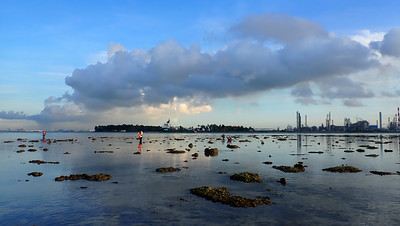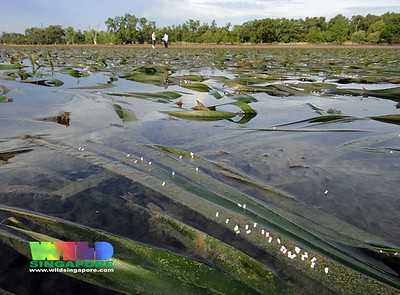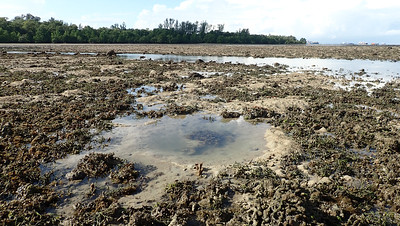
Although it's sad that the seagrasses have yet to recover, it was great that the team saw FOUR Giant clams today!
Although it lies opposite the petrochemical plants on Pulau Bukom, this shore is quite reefy.
Today, while some of the small boulder shaped colonies were bleaching, others were not.
Some species of corals were bleaching: Circular mushroom corals, Anchor corals. Others were doing fine.
I saw some leathery soft corals, most were small colonies. Most were alright. Except for a small patch with some colonies bleaching and some not.
A closer look at the patch.
The situation is not as bad as what I saw during mass coral bleaching here in 2016 (photo below).

I saw two Bubble tip anemones both bleaching. Kok Sheng saw one that was not. The Magnificent anemone, Giant carpet anemone and Frilly anemones I saw were not bleaching. Most of the zoanthids were okay although I saw a few with some bleaching, and a pale Sea mat zoanthid.
Kok Sheng spotted two anemones which are not common on our shores: the Leathery sea anemone.
And a beautiful banded version of the Merten's carpet anemone.
The team saw FOUR Fluted giant clams today. I missed all of them including this huge one at our departure point. Which was pointed out by Kok Sheng. I didn't see it even though I looked for it. Giant clams can also suffer from bleaching, so it was good to see that they were fine.
Here's the Giant clam that Jianlin found.
Kok Sheng walked far into the western portion of Semakau and saw many Knobbly sea stars!
The seagrass situation does not appear to be very different from what I saw at our last survey in Jun 2019. The TeamSeaGrass Site 2 stakes are still there! But there are still virtually no seagrasses at the Site.
This is what the Site used to look like in 2010 just before the seagrasses started to disappear.
Today, I saw sparse sprinkles of various kinds of seagrasses along the mid-water mark, as well as some parts of the 'lagoon' like areas of water left behind at low tide. Where there were more seagrasses, they were entangled in masses of seaweeds. I saw many scattered clusters of longish Tape seagrass (about 30cm) both the old seagrass areas as well as among the reefier edges.
There was an abandoned fish net near the low water mark. No animals were trapped in it, and it was well covered in epiphytes. It wound next to a hard coral which was alright, not bleaching.
There was also a large broken fish trap in the stream running into the sea.
This looks like a boat strike: an excavation of the reef flat when a boat strikes or is stuck on the reef at a lowish tide.
It was super hot and clear during our survey. No wonder this Malayan water monitor decided to cool off in the water at the reef edge!
Let's hope the shores and its residents stay safe until our next visit.
Pulau Semakau is NOT the Semakau Landfill
Just as Changi Airport and Changi Prison are not the same even though they are near one another and share a name, Pulau Semakau is NOT the same as the Semakau Landfill. The Landfill was created by destroying all of Pulau Saking, and about half of the original Pulau Semakau by building a very long seawall. Fortunately, the landfill was constructed and is managed in such a way that the original mangroves, seagrass meadows and reefs on Pulau Semakau were allowed to remain. The northern shore of Pulau Semakau is near the petrochemical plants on Pulau Bukom.

It is NOT true that the construction of the Landfill created the marine life found on Pulau Semakau. The marine life was there long before the Landfill was built.
As the existing half of the Landfill was used up, the Phase 2 of the Landfill was launched. This involved closing the gap of the seawall on the Semakau Landfill, forming one big pool where incinerated ash will be dumped. NEA worked to limit the damage to natural shoresduring the construction work for this expansion of the landfill.
The Singapore Blue Plan 2018
Pulau Semakau and nearby islands and submerged reefs have been recommended by the Singapore Blue Plan 2018 for Immediate Conservation Priority.
The Blue Plan recommends the intertidal and subtidal marine areas of Pulau Semakau and adjacent Pulau Hantu, and Pulau Jong to be designated Marine Reserve.
The Blue Plan highlights that Pulau Semakau and its associated patch reefs comprise many ecosystems: coral reefs, mangrove areas, intertidal sandflats, seagrass meadows, and coral reefs. The subtidal area of Pulau Jong is larger than the terrestrial area. Pulau Hantu is a popular dive site has seen increasing interest in the past decade due to biodiversity awareness. If protection is accorded to these three islands, zonation plans for use can be implemented to manage tourism and human impacts.
DOWNLOAD the Plan, SUPPORT the Plan! More on the Singapore Blue Plan 2018 site.
Posts by others on this survey
Loh Kok Sheng
Joleen Chan
Jianlin Liu
Marcus Ng
Other surveys
Chay Hoon surveyed Tanah Merah















